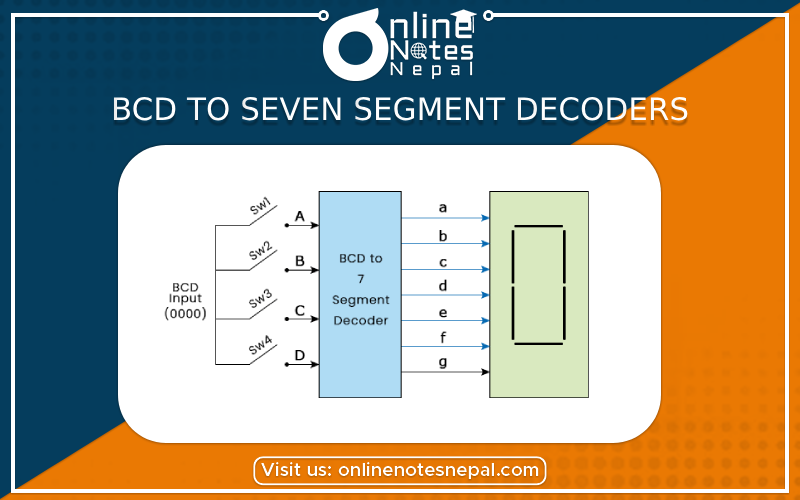Published by: Dikshya
Published date: 11 Jul 2023

BCD to Seven-Segment Decoders are commonly used in digital systems to convert Binary-Coded Decimal (BCD) representations of decimal numbers into signals that can drive a seven-segment display. A seven-segment display is a visual output device that can represent decimal digits (0-9) and some additional characters (such as A-F). A BCD to Seven-Segment Decoder typically has four input lines corresponding to the BCD code (BCD inputs: A, B, C, and D) and seven output lines corresponding to segments of the seven-segment display (output segments: a, b, c, d, e, f, and g).
The BCD inputs represent the binary representation of a decimal digit. For example, the BCD code for the decimal digit 0 is 0000, for 1 is 0001, for 2 is 0010, and so on, up to 9, which is represented by the BCD code 1001. The seven-segment display has seven segments (a through g) that can be individually turned on or off to represent different characters or digits. Each segment corresponds to a specific input combination of the BCD code.
A common mapping between BCD inputs and seven-segment outputs for decimal digits:
BCD Inputs (A, B, C, D) Seven-Segment Outputs (a, b, c, d, e, f, g)
-------------------------------------------------------------------
0 (0000) 1 1 1 1 1 1 0
1 (0001) 0 1 1 0 0 0 0
2 (0010) 1 1 0 1 1 0 1
3 (0011) 1 1 1 1 0 0 1
4 (0100) 0 1 1 0 0 1 1
5 (0101) 1 0 1 1 0 1 1
6 (0110) 1 0 1 1 1 1 1
7 (0111) 1 1 1 0 0 0 0
8 (1000) 1 1 1 1 1 1 1
9 (1001) 1 1 1 1 0 1 1
By decoding the BCD inputs according to this mapping, the corresponding segments on the seven-segment display can be activated to represent the desired decimal digit. BCD to Seven-Segment Decoders are often implemented using combinational logic circuits, such as logic gates and AND/OR combinations, to generate the appropriate output signals based on the BCD input. These decoders are commonly used in digital clocks, calculators, and various digital display applications
Here are some key uses and importance of BCD to seven-segment decoders:
1. Seven-Segment Display: A seven-segment display is a common type of electronic display that can represent decimal digits (0-9) and sometimes additional symbols (e.g., letters or special characters). Each segment in the display corresponds to a specific BCD input combination. The BCD to seven-segment decoder is used to convert the BCD code into the appropriate control signals to light up the segments and display the corresponding digit on the seven-segment display.
2. Numeric Data Display: BCD to seven-segment decoders are extensively used in digital devices where numeric data needs to be visually displayed. For example, calculators, digital clocks, digital meters, digital counters, and many other electronic devices employ seven-segment displays along with BCD to seven-segment decoders to show numeric values to users.
3. Easy Human Readability: Seven-segment displays are intuitive for human interpretation. By converting BCD data into the corresponding segment activation patterns, BCD to seven-segment decoders provide a convenient way to present numerical information in a format that is easily readable and understood by humans. This makes them ideal for applications where quick and accurate visualization of numerical data is important.
4. Simplified Circuit Design: BCD to seven-segment decoders simplify the design of circuits that need to interface with seven-segment displays. Instead of individually controlling each segment, designers can use a BCD to seven-segment decoder to handle the conversion from BCD to the appropriate segment control signals. This reduces the complexity of the circuit and eliminates the need for multiple logic gates or complex programming.
5. Compact and Efficient: BCD to seven-segment decoders are compact and efficient components that provide a direct mapping between BCD input values and the corresponding segment control signals. This efficient conversion enables the effective utilization of resources in digital systems, optimizing both space and power consumption.